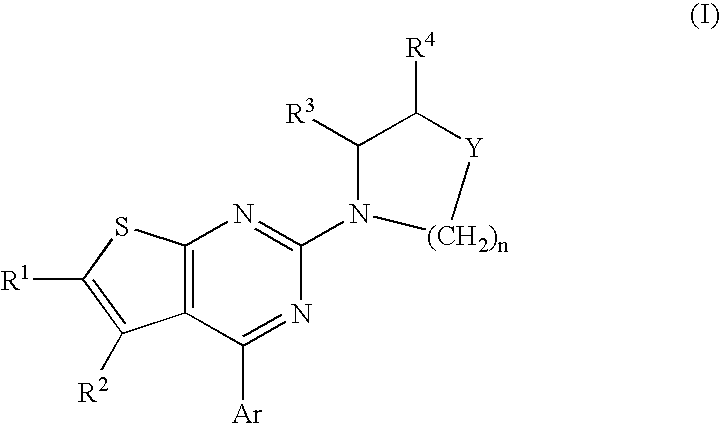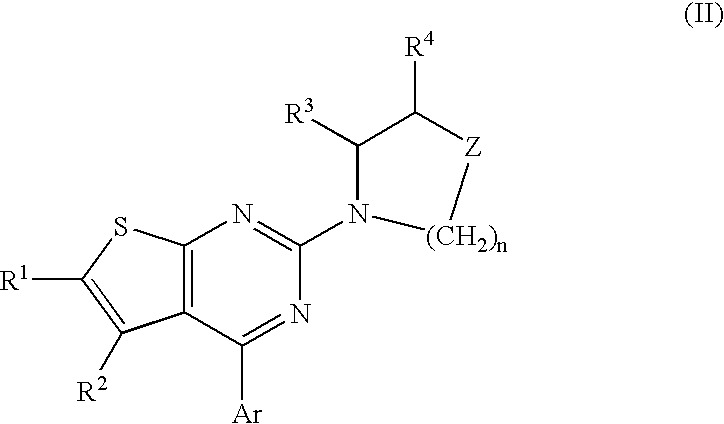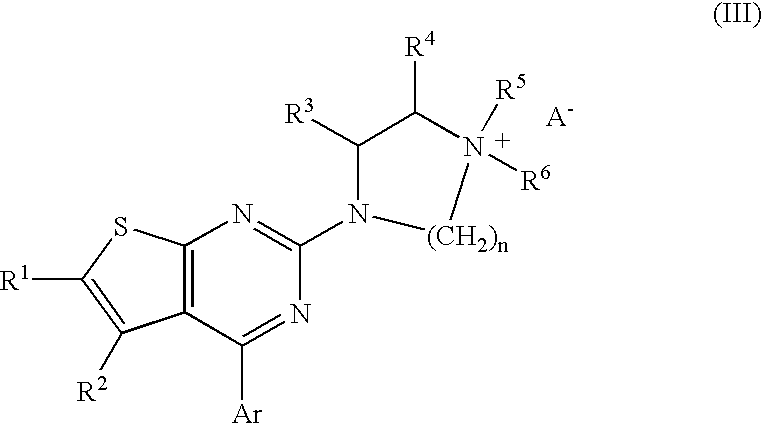Method of treating disorders and conditions using peripherally-restricted antagonists and inhibitors
a technology of antagonists and inhibitors, applied in the field of treating disorders and conditions using peripherally restricted antagonists and inhibitors, can solve the problems of extreme inflammation and distention of the large intestine, intestinal blockage, and the reduction of desirability of these agents, and achieve the effect of improving one or more symptoms
- Summary
- Abstract
- Description
- Claims
- Application Information
AI Technical Summary
Benefits of technology
Problems solved by technology
Method used
Image
Examples
example 1
Synthetic Preparation of an MCI-225-OUAT
[0368]
[0369] Compound A, 1.0 g, was combined with K2CO3, water (25 mL), and EtOAc (25 mL). The mixture was shaken in separatory funnel until all solids were dissolved. The organic phase was then removed. The aqueous phase was combined with an additional volume of EtOAc (25 mL) in the separatory funnel and shaken again. The organic phase was subsequently removed and combined with the first organic phase extraction.
[0370] The combined organics from both extractions were dried over MgSO4 with stirring. The combined organics were then filtered through CGF and concentrated to a solid, weighing 191 mg. The sold was then combined with K2CO3 (189 mg), MeI (86 uL) in DMF (4 mL). The reaction mixture is stirred at room temperature for 4 hrs, and monitored by TLC. The reaction mixture is then diluted with water (10 mL) and extracted with EtOAc (2×25 mL). The combined organics of this extraction were washed with water (50 mL), dried over MgSO4, and conc...
example 2
Assessment of Bioavailability of Test Compounds
[0373] Assessment of bioavailability from plasma concentration-time data involves determining the area under the plasma concentration-time curve (AUC). The AUC is directly proportional to the total amount of unchanged drug that reaches the systemic circulation. For an accurate measurement, blood is sampled frequently over a long enough time to observe virtually complete drug elimination.
[0374] Bioavailability is assessed after single and / or repetitive (multiple) dosing. More information about rate of absorption is available after a single dose than after multiple dosing. However, multiple dosing more closely represents the usual clinical situation, and plasma concentrations are usually higher than those after a single dose, facilitating data analysis. After multiple dosing at a fixed-dosing interval for four or five elimination half-lives, the blood drug concentration should be at steady state (the amount absorbed equals the amount el...
example 3
Blood Brain Barrier Penetrance of a Test Compound
[0379] The blood brain barrier penetrance of a test compound can be determined using an analysis based on the analysis described in Drug Metab Dispos. 2000 February;28(2):205-8 by Le Doze F et al.
[0380] Glacial acetic acid, acetonitrile and ammonium acetate (Merck, Darmstadt, Germany), ascorbic acid (Fluka Chimie A G, Bucks, Switzerland), dimethyl sulfoxide (DMSO), and trisodium edetate (Prolabo, Fontenay sous Bois, France) are all of analytical grade. The HPLC system used is an isocratic pump (model L6000; Merck, Darmstadt, Germany) coupled to a photodiode array detector (model 996; Waters, Saint-Quentin en Yvelines, France) monitored by Millenium software (Waters).
[0381] Experiments are performed on 95 male Sprague-Dawley rats (CERJ, Le Genest Saint Isle, France) weighing 200 to 300 g. The rats are housed in groups of five and maintained under standard laboratory conditions (22±1° C., 12-h light / dark cycle, food and water ad libi...
PUM
| Property | Measurement | Unit |
|---|---|---|
| Fraction | aaaaa | aaaaa |
| Fraction | aaaaa | aaaaa |
| Fraction | aaaaa | aaaaa |
Abstract
Description
Claims
Application Information
 Login to View More
Login to View More - R&D
- Intellectual Property
- Life Sciences
- Materials
- Tech Scout
- Unparalleled Data Quality
- Higher Quality Content
- 60% Fewer Hallucinations
Browse by: Latest US Patents, China's latest patents, Technical Efficacy Thesaurus, Application Domain, Technology Topic, Popular Technical Reports.
© 2025 PatSnap. All rights reserved.Legal|Privacy policy|Modern Slavery Act Transparency Statement|Sitemap|About US| Contact US: help@patsnap.com



